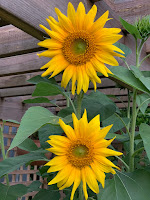So about once in each season, we begin by checking the volume of water remaining in our 40,000 litre concrete holding tank. Then we add the correct amount of liquid sodium hypochlorite to kill any bugs. We obtained information from our Council about the appropriate amount to add per 1000 litres; you should check for yourself what your council's health officers advise. Then you have to know the formula for working out the volume of a cylinder (V = πr2h). Mathematical calculations are a problem for anyone with aphasia, so Allen's happy to leave this part of the job to me. Even so, I need to look up the formula every time we do it! Allen keeps a long piece of bamboo for measuring the 'height' of water in the tank; the radius, of course, remains constant. So, using the radius and height-of-water data, we calculate the volume of water remaining. After that it's a simple matter of mixing
 the correct amount of sodium hypochlorite into a pailful of tap water, adding that to the tank and using the bamboo pole to mix it in and splash around the water in the tank. Not long after we finish this task, we will detect a faint odour of chlorine when turning on house taps or having a shower. It's no more than you would have in city water, of course, but here in the hinterland we notice it right away. That's why we also installed a chlorine-filtering water fountain on one side of the kitchen sink, so we never need to 'taste' chlorine in our drinking water. The chlorine smell soon dissipates. Anyway, a temporary odour is a small price to pay to know that any traces of animal faeces that may have washed into the water supply aren't going to give visitors diarrhea or stomach upsets.
the correct amount of sodium hypochlorite into a pailful of tap water, adding that to the tank and using the bamboo pole to mix it in and splash around the water in the tank. Not long after we finish this task, we will detect a faint odour of chlorine when turning on house taps or having a shower. It's no more than you would have in city water, of course, but here in the hinterland we notice it right away. That's why we also installed a chlorine-filtering water fountain on one side of the kitchen sink, so we never need to 'taste' chlorine in our drinking water. The chlorine smell soon dissipates. Anyway, a temporary odour is a small price to pay to know that any traces of animal faeces that may have washed into the water supply aren't going to give visitors diarrhea or stomach upsets.Postscript: In March 2010, a tank and water expert inspecting our tank informed me we should NOT be using sodium hypochlorite in a concrete tank, for a bunch of reasons he enumerated. And we should NOT boil our rainwater before drinking, because of the bad effect this can have on any gum leaf residue that may be in the water! (What about making tea, I ask! Get a product called 'Aqua-flo', he said, if you must do anything. Best of all, just keep the tank clean. Easy for him to say, when the only way to clean a 10,000 gallon tank is to first empty it out. Our water level hasn't fallen below half since we stopped using that water on the garden and got access to dam water for that purpose. Not easy to throw away 5000 gallons of good rainwater just for the sake of a spring clean.


No comments:
Post a Comment